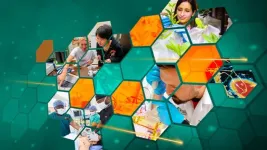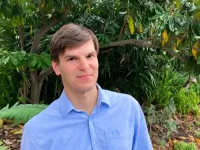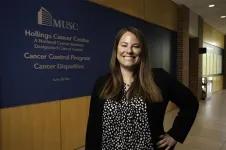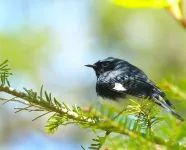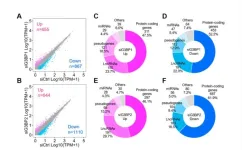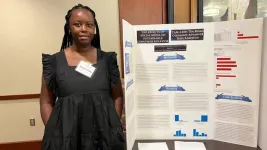(Press-News.org) Within superconductors little tornadoes of electrons, known as quantum vortices, can occur which have important implications in superconducting applications such as quantum sensors. Now a new kind of superconducting vortex has been found, an international team of researchers reports.
Egor Babaev, professor at KTH Royal Institute of Technology in Stockholm, says the study revises the prevailing understanding of how electronic flow can occur in superconductors, based on work about quantum vortices that was recognized in the 2003 Nobel Prize award. The researchers at KTH, together with researchers from Stanford University, TD Lee Institute in Shanghai and AIST in Tsukuba, discovered that the magnetic flux produced by vortices in a superconductor can be divided up into a wider range of values than thought.
That represents a new insight into the fundamentals of superconductivity, and also potentially can be applied in superconducting electronics.
A vortex of magnetic flux happens when an external magnetic field is applied to a superconductor. The magnetic field penetrates the superconductor in the form of quantized magnetic flux tubes which form vortices. Babaev says that originally research held that quantum vortices pass through superconductors each carrying one quantum of magnetic flux. But arbitrary fractions of quantum flux were not a possibility entertained in earlier theories of superconductivity.
Using the Superconducting Quantum Interference Device (SQUID) at Stanford University Babaev’s co-authors, research scientist Yusuke Iguchi and Professor Kathryn A. Moler, showed at a microscopic level that quantum vortices can exist in a single electronic band. The team was able to create and move around these fractional quantum vortices, Moler says.
“Professor Babaev has been telling me for years that we could see something like this, but I didn’t believe it until Dr. Iguchi actually saw it and conducted a number of detailed checks,” she says.
The Stanford researchers found the initial observation of this phenomenon “so incredibly uncommon,” says Iguchi, that they repeated the experiment 75 times in at various locations and temperatures.
The work confirms a prediction Babaev published 20 years ago, which held that in certain kinds of crystals, one part of an electron population of a superconducting material can form a clockwise circulating vortex, while other electrons can form a counter-clockwise vortex simultaneously. “These combined quantum tornadoes can carry an arbitrary fraction of flux quantum,” he says.
“That revises of our understanding of quantum vortices in superconductors,” he says.
Moler affirmed that conclusion. “I have been looking at vortices in novel superconductors for over 25 years, and I have never seen this before,” she says.
Babaev says that the robustness of quantum vortices and the possibility to control them suggests that quantum vortices could potentially be used as information carriers in superconducting computers.
“The knowledge that we gain, the spectacular methods that were introduced by our colleagues Dr. Iguchi and Professor Moler at Stanford, may in a long run be potentially helpful for certain platforms for quantum computation,” Babaev says.
END
Tiny quantum electronic vortexes can circulate in superconductors in ways not seen before
2023-06-01
ELSE PRESS RELEASES FROM THIS DATE:
University of Miami selected to prestigious Association of American Universities
2023-06-01
The University of Miami has been chosen as one of the newest members of the esteemed Association of American Universities (AAU), a distinguished national organization of leading research universities founded in 1900.
The invitation to join the prestigious organization—considered the gold standard in American higher education—comes as the University’s research and sponsored program expenditures totaled more than $413 million in fiscal year 2022, demonstrating a critical focus to address the world’s most complex issues.
“There are special moments in the life of a university that not only reward our hard work but, more importantly, ...
Dr. Robert Harrington named dean of Weill Cornell Medicine
2023-06-01
Dr. Robert A. Harrington, a cardiologist and the Arthur L. Bloomfield Professor of Medicine and chair of the Department of Medicine at Stanford University, has been named the Stephen and Suzanne Weiss Dean of Weill Cornell Medicine and provost for medical affairs of Cornell University.
The appointment was approved by the Cornell Board of Trustees and the Weill Cornell Medicine Board of Fellows. Harrington - also a member of the National Academy of Medicine - will begin his new position on Sept. 12.
A past president of the American Heart Association (AHA), ...
Early career scientist wins prestigious Hungarian physics award
2023-06-01
Laszlo Horvath, an early career physicist at the U.S. Department of Energy’s (DOE) Princeton Plasma Physics Laboratory (PPPL) stationed at General Atomics in San Diego, is the winner of the 2022 Károly Simonyi Memorial Plaque from the Hungarian Nuclear Society. Established in 2007, the plaque “recognizes Hungarian researchers and engineers with outstanding achievements in the field of fusion plasma physics and technology.”
Horvath learned he had won the Simonyi Memorial Plaque not long ...
More evidence needed to confirm promise of remote or decentralized trials
2023-06-01
There’s one question that Hollings Cancer Center researcher Jennifer Dahne, Ph.D., co-director of the remote and virtual trials program at the South Carolina Clinical & Translational Research Institute, hears more than any other as she consults with clinical researchers about how to set up remote trials, also known as decentralized trials. Will these trials overcome the barriers that make it difficult for minority and underserved populations to participate in clinical trials? It’s also a question she often discusses ...
Forest birds with short, round wings more sensitive to habitat fragmentation, OSU study shows
2023-06-01
CORVALLIS, Ore. – Tropical forest birds, which tend to have wings that are short and round relative to their body length and shape, are more sensitive to habitat fragmentation than the long-, slender-winged species common in temperate forests, according to an international collaboration that included scientists from Oregon State University.
OSU’s Matt Betts and Christopher Wolf teamed with 14 other authors to analyze the wings of more than 1,000 species worldwide in a study led by Thomas Weeks of Imperial College London and ...
Astrophysicists confirm the faintest galaxy ever seen in the early universe
2023-06-01
Key takeaways
After the Big Bang, the universe expanded and cooled sufficiently for hydrogen atoms to form. In the absence of light from the first stars and galaxies, the universe entered a period known as the cosmic dark ages.
The first stars and galaxies appeared several hundred million years later and began burning away the hydrogen fog left over from the Big Bang, rendering the universe transparent, like it is today.
Researchers led by astrophysicists from UCLA confirmed the existence of a distant, faint galaxy ...
Stress granules control Alzheimer's gene transcripts and neuronal proteostasis
2023-06-01
“Determining the mechanism underlying RNA sequestration in [stress granules] [...] could represent a key goal in the discovery and development of suitable [Alzheimer’s disease] biomarkers and therapies.”
BUFFALO, NY- June 1, 2023 – A new research paper was published on the cover of Aging (listed by MEDLINE/PubMed as "Aging (Albany NY)" and "Aging-US" by Web of Science) Volume 15, Issue 10, entitled, “Stress granules sequester Alzheimer’s disease-associated gene transcripts and regulate disease-related neuronal proteostasis.”
Environmental and physiological stresses ...
MU textiles professor earns grant as part of USDA’s Higher Education Challenge
2023-06-01
When you think about big data and fashion, it seems unlikely that the two might be stitched together. However, the modern fashion industry depends on data analytics throughout the supply chain to serve customers in ways that champion innovation, including expanding designers’ creativity, calculating the environmental impact of making a product and keeping brands up to date on changes in the market.
In an inventive project funded by a Department of Agriculture (USDA) grant of $149,000 awarded to Li Zhao, a professor of textiles and apparel management in the University of Missouri’s College of Arts and Science, students will ...
Deep-brain stimulation during sleep strengthens memory
2023-06-01
While it’s known that sleep plays a crucial role in strengthening memory, scientists are still trying to decode how this process plays out in the brain overnight.
New research led by scientists at UCLA Health and Tel Aviv University provides the first physiological evidence from inside the human brain supporting the dominant scientific theory on how the brain consolidates memory during sleep. Further, the researchers found that targeted deep-brain stimulation during a critical time in the sleep cycle appeared to improve memory consolidation.
The research, published June 1 in Nature Neuroscience, ...
School toolkits
2023-06-01
Children and young people naturally spend a large amount of their time at school, college or in other educational settings. Whilst most children with JIA are able to access education, many require adaptations or specific support to enable them to fully engage in learning. But families of children with JIA report lack of awareness and understanding, and believe that schools need special resources to be able to support these children and young people.
In the UK, Juvenile Arthritis Research (JAR) has developed a toolkit to allow teachers and school staff to confidently support children with JIA, and the initial rollout was assessed ...



